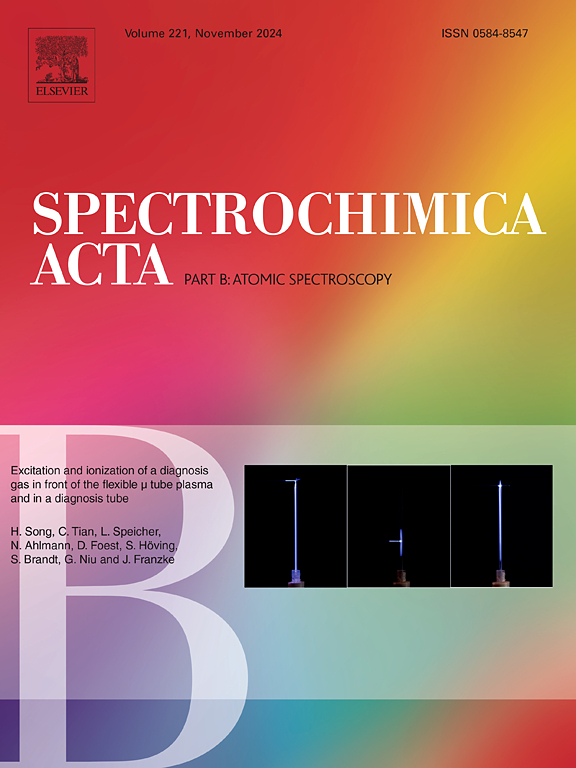Determination of the calorific value and ash content of coal using the analysis of primary X-ray radiation scattering spectra
IF 3.8
2区 化学
Q1 SPECTROSCOPY
引用次数: 0
Abstract
The study presents a new approach to the determination of the main fuel characteristics of coals, such as calorific value and ash content, using wavelength dispersive X-ray fluorescence analysis (WDXRF) in combination with partial least squares (PLS) regression. The Compton and Rayleigh scattering spectra of the primary radiation of the X-ray tube served as the basis for the quantitative assessment of these indicators.
The effect that spectral resolution has on the quality of the prediction was also assessed in the study. It was found that increasing the spectral resolution increases the accuracy of predicting the calorific value and ash content of coals. The use of a LiF (220) crystal analyzer in combination with a high-resolution collimator provided a root-mean-square error of 0.52 MJ/kg for an average calorific value of 29.06 MJ/kg, and 1.70 wt% for an average ash content of 9.20 wt% in validating the training set data. Although the current results of coal quality analysis obtained on the basis of primary X-ray scattering spectra cannot replace the already accepted methods, the presented approach can provide useful information for rapid assessment of coal quality and can be used in automated systems for quality control of incoming fuel.

用初级x射线辐射散射光谱分析测定煤的热值和灰分含量
该研究提出了一种利用波长色散x射线荧光分析(WDXRF)结合偏最小二乘(PLS)回归测定煤的主要燃料特性,如热值和灰分含量的新方法。x射线管一次辐射的康普顿散射光谱和瑞利散射光谱作为定量评价这些指标的基础。研究还评估了光谱分辨率对预测质量的影响。结果表明,提高光谱分辨率可以提高煤的热值和灰分的预测精度。在验证训练集数据时,使用liff(220)晶体分析仪与高分辨率准直仪相结合,平均热值为29.06 MJ/kg,均方根误差为0.52 MJ/kg,平均灰分含量为9.20 wt%,均方根误差为1.70 wt%。虽然目前基于一次x射线散射光谱的煤质分析结果不能取代现有的方法,但本文提出的方法可以为快速评价煤质提供有用的信息,并可用于进料质量控制的自动化系统。
本文章由计算机程序翻译,如有差异,请以英文原文为准。
求助全文
约1分钟内获得全文
求助全文
来源期刊
CiteScore
6.10
自引率
12.10%
发文量
173
审稿时长
81 days
期刊介绍:
Spectrochimica Acta Part B: Atomic Spectroscopy, is intended for the rapid publication of both original work and reviews in the following fields:
Atomic Emission (AES), Atomic Absorption (AAS) and Atomic Fluorescence (AFS) spectroscopy;
Mass Spectrometry (MS) for inorganic analysis covering Spark Source (SS-MS), Inductively Coupled Plasma (ICP-MS), Glow Discharge (GD-MS), and Secondary Ion Mass Spectrometry (SIMS).
Laser induced atomic spectroscopy for inorganic analysis, including non-linear optical laser spectroscopy, covering Laser Enhanced Ionization (LEI), Laser Induced Fluorescence (LIF), Resonance Ionization Spectroscopy (RIS) and Resonance Ionization Mass Spectrometry (RIMS); Laser Induced Breakdown Spectroscopy (LIBS); Cavity Ringdown Spectroscopy (CRDS), Laser Ablation Inductively Coupled Plasma Atomic Emission Spectroscopy (LA-ICP-AES) and Laser Ablation Inductively Coupled Plasma Mass Spectrometry (LA-ICP-MS).
X-ray spectrometry, X-ray Optics and Microanalysis, including X-ray fluorescence spectrometry (XRF) and related techniques, in particular Total-reflection X-ray Fluorescence Spectrometry (TXRF), and Synchrotron Radiation-excited Total reflection XRF (SR-TXRF).
Manuscripts dealing with (i) fundamentals, (ii) methodology development, (iii)instrumentation, and (iv) applications, can be submitted for publication.

 求助内容:
求助内容: 应助结果提醒方式:
应助结果提醒方式:


